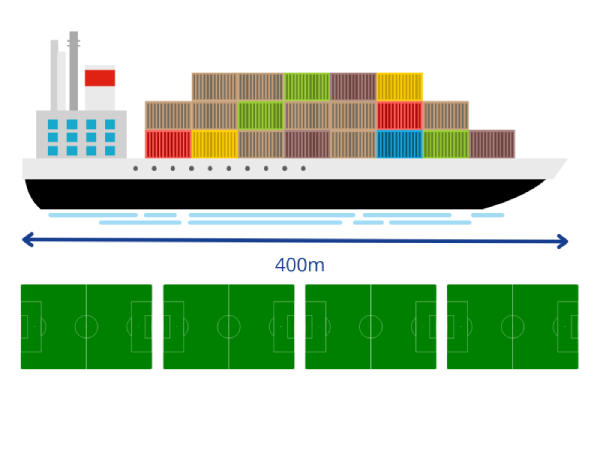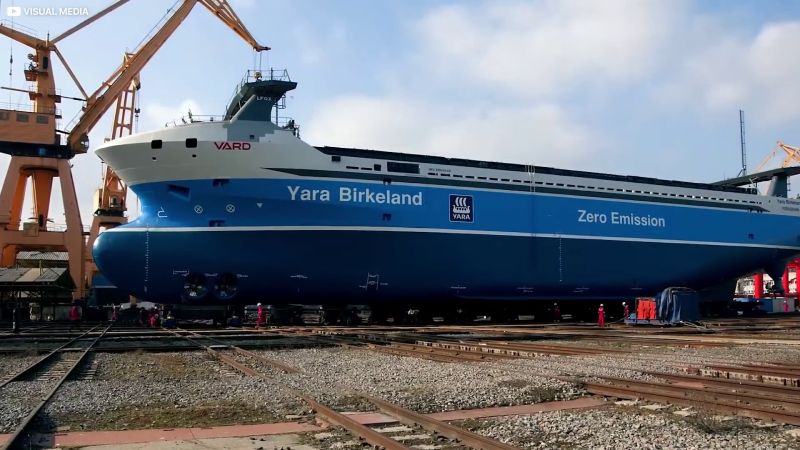How Many Containers on a Container Ship? You’ll Be Amazed!
International shipping is a complex process with many steps and players involved. From the moment an order is placed to when it arrives at its destination, many factors ensure everything goes smoothly. One of the most important aspects of shipping is the cargo itself.
There are up to 24,346 containers on a single container ship! You’ll find all types of cargo on these ships, including raw materials, food, and manufactured goods. These types of goods cross the ocean every day. The U.S. is the largest exporter globally.
Are you surprised by the number of containers on a ship? Keep reading as I discuss the topic further!
What Is the Average Number of Containers on a Ship?
Container ships are a vital part of international trade. They can carry a large amount of cargo and travel to many different ports. The number of containers on a ship influences many factors regarding international trade.
For example, the size and type of vessel needed, the cost of shipping, and how long it’ll take all depend on how much cargo is being transported.
The average number of containers on a ship is approximately 15,000. That number can vary greatly depending upon the type of vessel and its cargo capacity. For example, larger vessels like the Irina, and Loreto can hold up to 24,346 containers, while smaller vessels may only hold 600.
With such a large amount of containers being transported on a single ship, it’s not hard to see why international shipping has become so integral to modern logistics. But it wasn’t always this way!
Shipping Containers Make International Shipping Easier
Standardized containers that could be loaded onto ships for cargo transport first became popular in the 1950s. Before that, the cargo was loaded onto ships one piece at a time, making shipping very slow and expensive.
Current largest container ships in the world
| Number of containers (Maximum Loading Capacity in TEU*) | Number of largest container ships existing in the world |
|---|---|
| 24,346 | 2 (MSC) |
| 24,116 | 2 (MSC) |
| 24,004 | 3 (Evergreen) |
| 23,992 | 6 (Evergreen) |
| 23,964 | 7 (HMM) |
| 23,820 | 5 (HMM) |
| 23,756 | 6 (MSC) |
| 23,656 | 10 (MSC) |
| 23,112 | 9 (CMA-CGM) |
| 21,413 | 6 (OOCL) |
| 21,237 | 6 (COSCO) |
| 20,954 | 3 (CMA-CGM) |
| 20,568 | 11 (MAERSK) |
| 20,182 | 2 (ONE) |
| 20,170 | 4 (ONE) |
| 20,160 | 4 (Evergreen) |
| 20,124 | 7 (Evergreen) |
| 20,119 | 5 (COSCO) |
The invention of the shipping container made cargo transport by sea economically feasible. And once ports started to specialize in handling containers, it opened up a whole new world of international trade.
Unveiling the Massive MSC Irina: The New 24,346 TEU Container Vessel
How many shipping containers are there in the world 2022?
Today, over 17 million shipping containers are used worldwide, which is constantly growing. With global trade expanding rapidly, the demand for efficient cargo transport will only grow as well.

Supply and demand have facilitated growth and change since the first standardized containers, but they’re not the only factors that have impacted how many containers are on a container ship! The size of containers over the years has affected the number as well.
A Growing International Trade Means More Shipping Containers
Understanding why there are such drastic differences in container ship sizes requires understanding the history of shipping containers.
While some of the first containers measured 35 ft long and 8 ft wide (10.7 m long and 2.4 m wide), over the years, the size and capacity of containers have grown along with international trade. While containers today may be as large as 40 ft (12 m) long, all have the same width of 8 ft (2.4 m). Today’s average container size is 20 ft long and 8 ft wide (6 m long and 2.4 m wide).
Big or small, shipping containers are a vital part of the global supply chain. And as international trade continues to grow, their demand will only increase. So the next time you’re wondering how many containers are on a container ship, remember that it’s a lot!
What Is the Impact of Today’s Shipping Industry?
Today, shipping companies work with manufacturers to build new, larger container ships. It occurs when there is an increased demand for shipping capacity, which pushes the limits of current vessels.
But designing the next generation of container ships is not easy. Engineers must balance port congestion, maximum capacity, ship size, fuel consumption, and environmental impact when building a container ship. The design and building processes can take up to 3 years!
The shipping industry’s impact on the world is an increase in international trade and shipping containers. As supplies and demands increase, ships will continue to grow in size. The latest ships hold over 20,000 shipping containers.

These behemoths of the sea can reach nearly 400m long and 60m wide (1,312ft long and 197ft wide), almost the length of 4 football fields! For perspective, such a ship would tower over most skyscrapers at 40 stories high! That’s why engineers are working diligently to design new ships that can handle all of the expected capacity in international shipping.
Largest Shipping Container Ships
One of the largest container ships on the planet is the MSC Oscar. It can carry over 19,000 TEUs (20-foot or 6-meter equivalent units) at once. That’s enough space for over one million refrigerators or 3 million laptop computers!
The MSC Oscar was completed in 2015 and is currently operated by the Mediterranean Shipping Company. It measures 59 m wide, 395 m long, and 73 m high (193.5 ft wide, 1,295 ft long, and 240 ft high). That’s a lot of containers!

No other container ship can compare to the HMM Algeciras when it comes to sheer size. This gargantuan vessel is the largest in the world at a whopping 400 m long and 61 m wide (1,312 ft long and 200 ft wide). It can carry up to 24,000 TEUs with a maximum load of 228,283 tons (207,095 MT).
Launched in 2020 and built by Daewoo Shipbuilding & Marine Engineering, this mega-ship holds more containers than any other vessel on the planet. It’s also environmentally friendly, with a lower carbon output than many other container ships.
What the Future Holds for Container Ships
The future of shipping is in high-tech, ultra-efficient vessels that can carry thousands of containers at a time while using less fuel and emitting fewer emissions. In fact, the first-ever fully electric container ship, Yara Birkeland, set sail from Norway in November of 2021. This ship is owned by Yara International and is named after the company and its founder, Kristian Birkeland.

This new container ship truly represents the future of cargo transport by sea. If it proves successful, we’ll likely see more electric vessels like Yara Birkeland from other shipping companies in the years to come.
The Yara Birkeland has a capacity to carry around 120 standard shipping containers (20-foot-long).
Cost-efficiency and the ability to transport a massive amount of cargo safely and quickly is what has driven containerization from its beginnings in the 1950s to where it stands today. As a result, we’re only going to see more shipping containers and larger container ships as time goes on.
However, shipping will likely move towards more technologically advanced vessels with increased consideration of emissions and environmental impact. In addition, with the rapid growth of international trade, containers will play a growing role in the future of our world economy.
Sources
- The Maritime Executive: A Brief History of the Shipping Container
- Ship Technology: MSC Oscar Container Ship
- Yara Birkeland: Vessel estimated key figures and facts








I had no idea of the number of ships and the sheer volume of the shipping industry. Love what was written and the completeness of the information.
My pleasure!